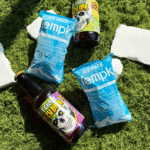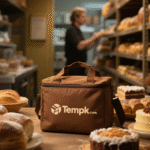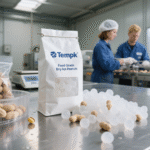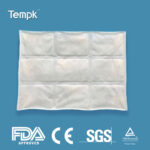Shipping fresh seafood requires precise temperature control, Dan reusable dry ice blocks for seafood give you long lasting cooling without the waste. These innovative blocks harness phase change materials that hold temperatures from –20 °C to 5 ° C., protect against leaks and can be refrozen hundreds of times. With online seafood orders rising and 27 % of consumers reporting temperature problems during food deliveries, choosing the right cooling strategy is vital. This guide explains how reusable dry ice blocks work, why they are superior to single use ice, and how to pack seafood safely and sustainably.

What are reusable dry ice blocks and how do they keep seafood fresh? – we’ll examine phase change materials and compare them with traditional gel packs.
Why choose reusable dry ice blocks over single use ice? – learn how these blocks reduce waste and save money while maintaining ultra cold temperatures.
How do you pack seafood for shipping in 2025? – step by step instructions covering container choice, layering and labeling.
What regulations and safety tips apply when shipping seafood with dry ice? – understand labeling requirements, quantity limits and protective gear.
What are the latest trends and innovations in cold chain packaging? – discover smart sensors, biodegradable materials and sustainability programs shaping the industry.
What Are Reusable Dry Ice Blocks and How Do They Work?
Reusable dry ice blocks, sometimes called dehydrated dry ice sheets, combine water filled cells with phase change materials (PCMS) that freeze at very low temperatures. When pre soaked and frozen, they provide stable cooling without becoming liquid. Tidak seperti es biasa yang meleleh ke dalam air, traditional dry ice sublimates at –78.5 °C, producing carbon dioxide gas and leaving no residue. Reusable blocks harness similar thermal properties but in a reusable format: PCMs absorb and release heat over a controlled range – typically –20 °C to 5 °C – acting like a rechargeable battery for cold storage.
Key features of modern reusable dry ice blocks
Reusable dry ice blocks are designed for versatility and sustainability. Fitur utama termasuk:
| Fitur | Reusable Dry Ice Block | Paket Gel Tradisional | Manfaat praktis |
| Kisaran suhu | –20 °C hingga 5 ° C. | 0 ° C ke 5 ° C. | Suitable for frozen seafood and broader applications |
| Lifespan | 500+ reuses | Single or few cycles | Saves money and reduces waste |
| Risiko bocor | Minimal to none | Moderate to high | Keeps packaging dry and prevents contamination |
| Eco friendliness | High – reusable and recyclable | Rendah (often plastic waste) | Supports sustainability goals |
| Status peraturan | Classified as non hazardous, menyederhanakan kepatuhan | Typically non hazardous | Fewer shipping restrictions |
These blocks often arrive as flat sheets. When soaked in water they expand into cell based packs that remain flexible when frozen, making them easy to cut or fold. High quality models use multi layer construction: two heavy duty washable plastic surfaces and two inner textile layers to resist punctures and insulate against external heat. Such durable construction allows them to be reused for years.
How phase change materials keep seafood cold
PCMs in reusable dry ice blocks change from solid to liquid at specific temperatures. Saat mereka meleleh, they absorb significant latent heat, maintaining a near constant temperature around their melting point. This ensures seafood stays at a safe 32 ° f (0 ° C.) for fresh products or –20 °F (–29 °C) for frozen items. Because PCMs release heat gradually, they prevent hot spots that could spoil delicate items. A 2024 study found that reusable dry ice sheets reduced temperature excursions by 25 % compared with traditional cooling methods.
Benefits of Using Reusable Dry Ice Blocks for Seafood Shipping
Superior thermal performance
Es kering menghasilkan suhu yang sangat dingin, but it sublimates quickly and is single use. Reusable blocks, sebaliknya, maintain deep freeze temperatures for longer periods. Misalnya, heavy duty reusable ice sheets can stay frozen for days—six times longer than water ice and three times longer than standard gel packs when used at similar volumes. They remain flexible when frozen and contain non toxic, food grade polymers, making them safe for seafood.
Reusable blocks also weigh less than equivalent volumes of ice or gel packs. Regular dry ice is lighter than water ice, but it sublimates into gas and must be replenished for each shipment. Reusable blocks eliminate repeated purchases, cutting costs over time.
Environmental and cost benefits
Sustainability is becoming a driving factor in cold chain packaging. Consumers are willing to pay nearly 9.7 % more for goods that are sustainably produced or sourced. Reusable dry ice blocks directly support this goal by reducing single use plastic and CO₂ emissions. Some manufacturers offer return programs where gel packs can be collected, sanitised and reused, further lowering waste and carbon footprint.
Although phase change materials have higher upfront costs, their longevity provides significant savings. Multiple reuse cycles reduce long term expenses, while diminished waste disposal lowers environmental impact. Sebaliknya, dry ice must be repurchased for each shipment, and hazardous material rules add logistical complexity.
Versatility beyond seafood
Reusable dry ice blocks serve more than seafood shipping. They are also ideal for pharmaceuticals, Makanan penutup beku, and even outdoor recreation. Techni Ice blocks double as heat packs, providing warmth when microwaved and cold when frozen. Tempk’s hydrate dry ice packs are used for meat, buah, sayuran, es krim, flowers and medical samples. Their lightweight, space saving design means they arrive thin as paper before soaking, reducing storage and transport costs.
Real world impact
Reusable cold packs aren’t just theoretical. A pharmaceutical company in Europe switched to reusable dry ice sheets and achieved a 40 % reduction in packaging costs and a 15 % decrease in product spoilage within six months. Another logistics company that adopted maintenance protocols extended the average sheet lifespan from 400 ke 600 penggunaan, penghematan $5,000 per facility annually. These success stories illustrate the tangible benefits of investing in reusable technology.
How to Pack Seafood with Reusable Dry Ice Blocks
Step by step packing guide
Proper packaging ensures that seafood arrives fresh without freezer burn. Ikuti langkah-langkah ini:
Choose an insulated container. Use a sturdy foam or hard sided cooler that slows temperature changes. Avoid airtight containers—ventilation is necessary to prevent pressure build up from sublimating dry ice.
Pre condition the container and blocks. Pre cool the empty cooler in a freezer or cold room for at least 60 menit. Soak reusable blocks in water for about 15 menit sebelum dibekukan, then freeze them 12–24 hours in advance for maximum cold.
Lapisan dengan benar. Place a layer of dry ice or reusable blocks at the bottom. Add the seafood in leak proof, airtight packaging. Wrap delicate fillets in moisture resistant materials to prevent contamination. Add another layer of blocks on top.
Separate compartments. Keep dry ice separate from direct contact with food to avoid freezer burn. Many containers include a divider for this purpose.
Segel dan beri label. Secure the lid with tape and create a small vent hole (tentang 3 mm) to release gas. Label the package with “Dry Ice” or “Perishable,” indicate the net weight of dry ice and include handling instructions.
Calculate quantity. Aturan umumnya adalah menggunakan 0.25 lb of dry ice per liter of container volume for a 48 hour trip. Untuk pengiriman yang tahan lama 24 jam, 5–10 pounds of dry ice is sufficient for a small cooler. Adjust depending on ambient temperature and container size.
Choose your carrier and timing. Opt for expedited services like next day delivery to reduce transit time. Confirm that your carrier is familiar with dry ice regulations.
Bag size and dry ice quantity chart
| Ukuran tas | Inner Dimensions (inci) | Es kering untuk 24 H | Es kering untuk 48 H | Kargo khas | Apa artinya bagimu |
| 5 L pouch | 8 × 6 × 3 | 0.8 lb | 1.2 lb | Small insulin pens | Ideal for small seafood samples or caviar |
| 12 L tote | 12 × 8 × 5 | 2 lb | 3 lb | Fillet makanan laut | Suitable for moderate shipments of fillets or shrimp |
| 20 L satchel | 14 × 10 × 7 | 3 lb | 5 lb | Gene therapy vials | For large seafood orders or mixed cargo |
Practical tips and case insights
Seafood subscription boxes: Use high performance insulated liners with at least 12 mm closed cell foam to reduce thawed returns by 48 %.
Power outages: Placing a frozen dry ice block in your refrigerator helps maintain safe temperatures during outages, saving energy.
Outdoor fishing trips: Hydrate dry ice packs are perfect for camping or boating; place them in cooler bags to keep the day’s catch chilled.
Kasus dunia nyata: A Midwest meal kit brand reduced thawed returns by 48 % after switching to insulated foam bags paired with vented dry ice pouches. Their investment paid back in two months, demonstrating that thoughtful packaging choices improve profitability and customer satisfaction.
Pertimbangan Keamanan dan Peraturan
Dry ice is classified as a hazardous material because it sublimates into carbon dioxide gas, which can displace oxygen in enclosed spaces. Regulatory agencies—including the Federal Aviation Administration (FAA) and United States Postal Service (USPS)—set rules for packaging, labeling and quantity limits.
Labeling and quantity limits
Pelabelan: Packages must be marked “Dry Ice” and display the net weight of dry ice. Include handling instructions and declare the presence of dry ice to the carrier.
Batas kuantitas: USPS allows a maximum of 5 pounds of dry ice per package. Airlines cap parcels at 6.6 lb (3 kg) each and require vented packaging.
Pernyataan: Carriers must be informed about shipments containing dry ice so they can follow appropriate handling procedures.
Handling and safety tips
Protective gear: Always wear insulated gloves and eye protection to prevent frostbite and eye irritation. Dry ice can cause skin burns in seconds.
Ventilasi: Store and transport packages in well ventilated areas to prevent carbon dioxide accumulation.
Separate compartments: Keep dry ice or reusable blocks in separate compartments or sealed pouches to avoid direct contact with seafood.
Pembaruan Pengaturan: Keep abreast of evolving rules—PFAS free foams and recycled CO₂ requirements are coming into force by Q4 2025.
Failure to follow these guidelines can result in shipment delays, fines and compromised food safety. Always consult your carrier’s latest documentation before shipping.
Innovations and Trends for 2025
Sustainability leads the way
Customers and regulators are pushing for sustainable packaging. Companies are developing biodegradable gel packs, reusable options and return programs. Businesses that adopt these practices reduce waste and carbon footprints while appealing to eco conscious consumers. Menurut a 2024 Voice of the Consumer survey, consumers are willing to pay almost 10 % more for sustainably produced goods.
Smart technology and real time monitoring
Temperature tracking and smart packaging are becoming standard. Sensors embedded in gel packs or reusable blocks monitor temperatures in real time. When a shipment warms unexpectedly, businesses receive immediate alerts, helping them intervene before spoilage occurs. Companies using real time monitoring have reduced product spoilage by as much as 30 %.
Di dalam 2025, reusable sheets with built in Bluetooth or LTE connectivity provide live data feeds. Some models include smart sensors that change color when temperature thresholds are exceeded. These innovations allow shippers to maintain full visibility across the supply chain.
Biodegradable materials and circular economy
Biodegradable PCMs and PFAS free foams are entering the market. Recycled dry ice credits and circular return programs encourage businesses to reclaim and reuse materials. A 2025 report by Green Cold Chain Alliance noted that companies using advanced reusable sheets cut carbon emissions by 25 % compared with 2024. Circular economy models not only reduce waste but also enhance brand reputation.
AI dan analisis prediktif
Artificial intelligence helps companies optimise routes, identify risks and adapt to disruptions. Combined with reliable gel packs and smart packaging, AI enhances resilience even when supply chains face climate events or demand surges. Businesses that adopt these tools will be better prepared for whatever 2025 brings.
Market snapshot
Recycled CO₂ credits: European and U.S. regulations grant fee rebates for shipments using over 50 % reclaimed dry ice.
Colokan ventilasi pintar: Adoption is expected to rise from 18 % di dalam 2024 ke 45 % di dalam 2025, reducing bag ruptures.
Return logistics loops: Return programs could cover 40 % of shipments by 2025, cutting liner waste significantly.
Pertanyaan yang sering diajukan
How long will a reusable dry ice block keep seafood frozen?
Reusable dry ice blocks can maintain frozen temperatures for 48–72 hours depending on the insulation and ambient conditions. Pre freeze them for 12–24 hours and use insulated containers to extend hold time.
Can reusable dry ice blocks be used multiple times?
Ya. High quality PCMs allow blocks to be refrozen hundreds of times without losing performance. Maintain them by cleaning with mild detergents and storing flat in a freezer.
What size block do I need for a 10 pound seafood shipment?
For a 10 pound (approx. 4.5 kg) shipment in a 12 L cooler, use roughly 2 pon es kering untuk 24 hours or 3 pon untuk 48 jam. Adjust based on outside temperature and transit time.
Are reusable dry ice blocks safe for food contact?
Most reusable blocks are made from non toxic materials and are food grade. Keep them in separate compartments or wrap them to avoid freezer burn.
What happens if a shipment is delayed?
Delays can compromise temperature control. Always track your shipment and choose carriers experienced in handling perishable goods. If the package arrives warm, inspect seafood immediately and discard any items that smell off or show discoloration.
Ringkasan dan Rekomendasi
Reusable dry ice blocks offer a sustainable, cost effective way to ship seafood at the right temperature. By harnessing phase change materials that maintain –20 °C to 5 ° C., they provide longer cooling than traditional ice or dry ice and can be reused hundreds of times. Their leak proof construction keeps shipments dry, and their flexibility allows easy packing.
To maximise success, select durable insulated containers, pre condition your blocks and container, layer correctly and follow labeling rules. Keep abreast of evolving regulations and embrace smart monitoring to reduce spoilage. Sustainable practices—return programs, biodegradable materials and recycled CO₂ credits—will not only cut costs but also appeal to eco conscious customers.
Langkah selanjutnya yang dapat ditindaklanjuti
Audit your packaging: Evaluate the size of your shipments and calculate the necessary amount of reusable dry ice using the 0.25 lb per liter rule.
Invest in quality blocks: Choose food grade, puncture resistant blocks with high density PCMs and certifications for safety.
Menerapkan pemantauan cerdas: Adopt temperature sensors or data loggers to track internal temperatures in real time.
Latih tim Anda: Provide training on handling, venting and labeling procedures to meet FAA and USPS regulations.
Engage with sustainability programs: Participate in return logistics loops or carbon credit initiatives to reduce waste and appeal to conscientious customers.
Tentang tempk
Tempk is a pioneer in eco optimized cold chain solutions. The company designs kits that blend recycled dry ice with smart insulated bags and real time telemetry. Its hydrate dry ice packs feature non toxic materials, lightweight construction and customizable sizes, making them ideal for seafood, pharmaceuticals and outdoor applications. R Tempk&D centre focuses on sustainable materials and IoT integration, ensuring customers can ship colder, greener and smarter.
Panggilan untuk bertindak: Whether you manage a seafood business or need to ship temperature sensitive goods, Tempk offers reusable ice packs and insulated solutions tailored to your needs. Contact their experts to design a custom cold chain system that reduces waste and safeguards your products.























